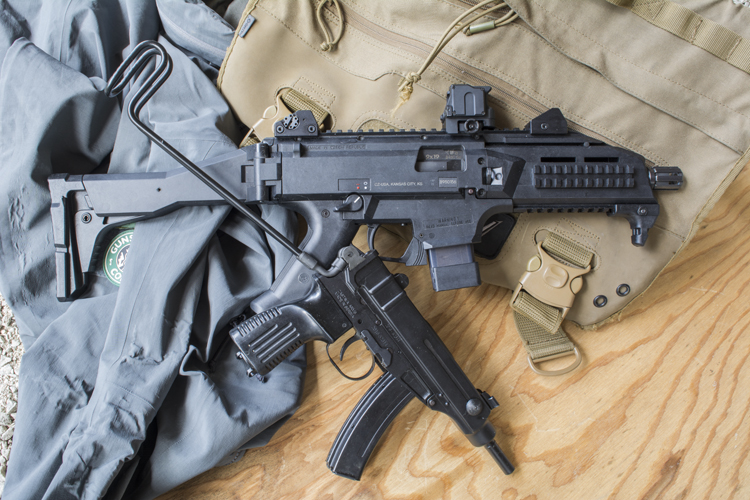
It’s no secret that we at Calibre Magazine have a real weakness for pistol calibre carbines, submachine guns, and every variant thereof. We’re perfectly aware of their downfalls, we know all the ballistic arguments, and we don’t need any more hate mail.
But there’s this 1980s charm to them we can’t get past. And take the most outrageous of all the great submachine guns, the Vz. 61 Skorpion, chambered in the essentially pointless .32 ACP, known in Europe as the 7.65mm Browning. Why? Whose idea was this? Well, technically, the idea was Miroslav Rybář’s, in 1959, and the reason for the tiny cartridge was that at the time, that was what the Czechoslovakian security forces issued. But despite their obvious drawbacks, Skorpions rock us like a hurricane.
If you’d have expected the original Skorpion to lead nowhere, especially after attempts to adapt its fascinating recoil system to larger calibres went poorly, you probably had a lot of company. It’s a weird little machine pistol that few can explain well, and that doesn’t usually make for the beginning of a significant branch of the evolutionary tree.
And yet CZ couldn’t stop tinkering with it. Even as other manufacturers moved away from submachine guns, as police forces transitioned from classic options like the Heckler & Koch MP5 to compact carbines, CZ toyed with variants of the design, searching for something that checked all the right boxes of compact, reliable, and effective. And the third iteration may be the one: the CZ Scorpion Evo 3, a railed-up, ergonomic, action movie henchman prop of matte black polymer and steel, chambered in the popular and ballistically proven 9mm Parabellum.
How does the modern rendition relate to the original? We don’t even know. But we know how to find out: take one of each and go to town, Calibre Magazine style. And that’s how we came to get our hands on the Orpion sisters: SC and SK... and pit Skorpion vs Scorpion. Which one gets the marriage proposal? Read on.
These days, it’s easy to think that the intransigent, rioting, peevish left wing is unprecedented in its ignorant opposition to fundamental freedoms, but the reality is that it used to be quite a bit worse. Back in the 1960s and 70s, you pretty much had to declare allegiance to the USSR to get a job at a liberal arts college, and at that time they actually had concrete examples spread over half of the northern hemisphere of just how stupid that entire philosophy was. But no matter: far left terrorism was extremely hip at the time, and even in the one place where you could literally look across the street and see how much worse things could be, divided Berlin, there were “radical chic” terrorist movements devoted to advancing communism, the most famous of these being the Red Army Faction, originally known as the Baader-Meinhof Group.
Groups like Baader-Meinhof, being of course the Utopian, altruistic people that political radicals always believe themselves to be, focused primarily on blowing things up, shooting people, and robbing banks. And in those days, you could not possibly be cool while carrying out a people’s liberation action (sponsored by those champions of liberation, the East German secret police) if you didn’t have a Vz. 61 Skorpion.
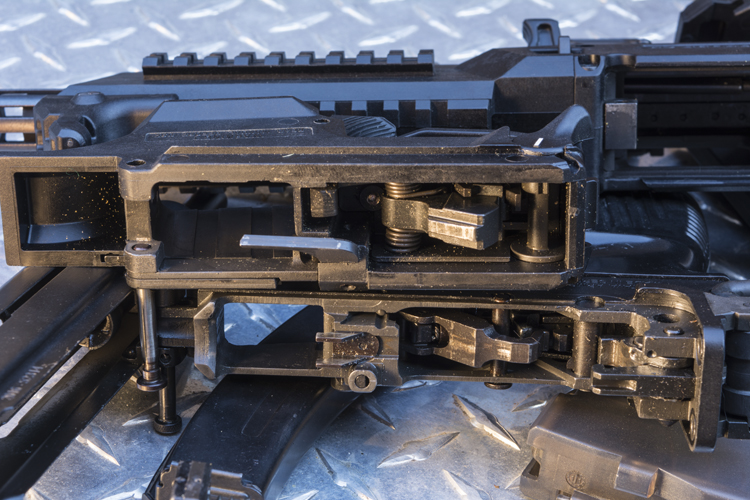
We’re not entirely sure why these were so popular with the 1970s cafe assassins, but they were. As noted, the 7.65mm Browning is pretty mediocre at the best of times, and with the primitive terminal ballistics available at the time, they would have been pretty poor performers on human targets. Certainly bursts on full auto must have sounded fearsome: the cyclic rate is adjustable but typically tuned to between 850 and 900 rounds per minute, which makes for an impressive staccato buzz that might be inherently appealing to Marxists, considering their apparent penchant for things that sound great at first, but didn’t work well in the real world. But the Skorpion is a fascinating piece of history: it’s pure blowback, relying on the mass of the bolt and the return springs to hold it in place during firing. Ordinarily, blowback guns are known for their harsh recoil, but the use of the .32 ACP round meant that bolt mass could be reduced, and in fact in rapid fire the Skorpion is incredibly stable. Handing the Vz. 61 to new shooters, and smaller shooters, is universally entertaining: they love the negligible recoil and ease of use. It’s also tiny, so the ability to deliver a burst of automatic fire from an easily concealed weapon may have had some strategic value for its users, perhaps increasing its value as a propaganda tool. This extraordinarily compact profile is derived from a combination of unique features: the bolt carrier partially shrouds the barrel, for example, allowing for increased mass without adding to the length or bulk of the receiver, and the recoil is managed partly by a curious inertial dampener tucked into the grip.
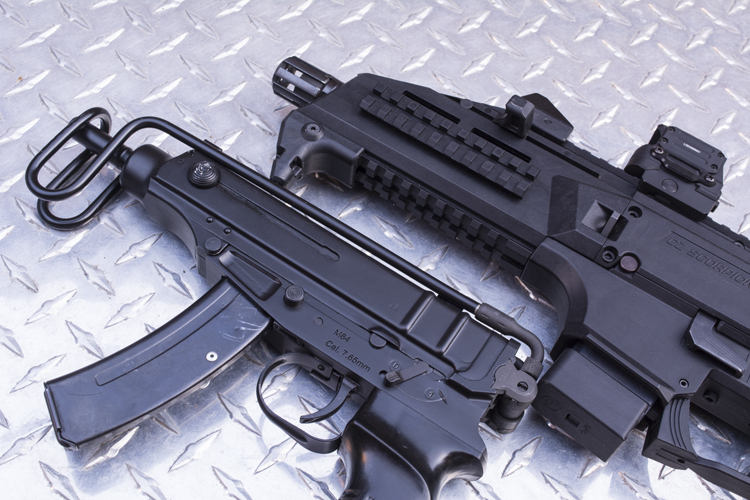
The damping mechanism is clockwork genius: the bolt actually locks back on every shot when it reaches its maximum rearward travel, activating a cam which simultaneously hooks the bolt as it drives a small weight downwards in the grip, which is then sent back up with a spring and returns the cam to its resting position, unlocking the bolt and allowing it to travel forward to chamber the next round. Adjustments are possible within the mechanism to control the rate of fire in full automatic mode, a feature sadly unavailable to Canadian users. The experience of firing the Skorpion improves the faster it goes; it’s not until the user begins to rail off the rounds at maximum speed that the stability in rapid fire becomes apparent. It feels like holding a power drill: tiny, controlled motion that hardly takes the shooter off target at all. It’s possible to approximate the experience if your split times are fast enough; Calibre has a staff member who can do 6 rounds a second with the Skorpion and while it’s less than half the cyclic rate, with 5 round magazines, well, that’s as good as it’s going to get.
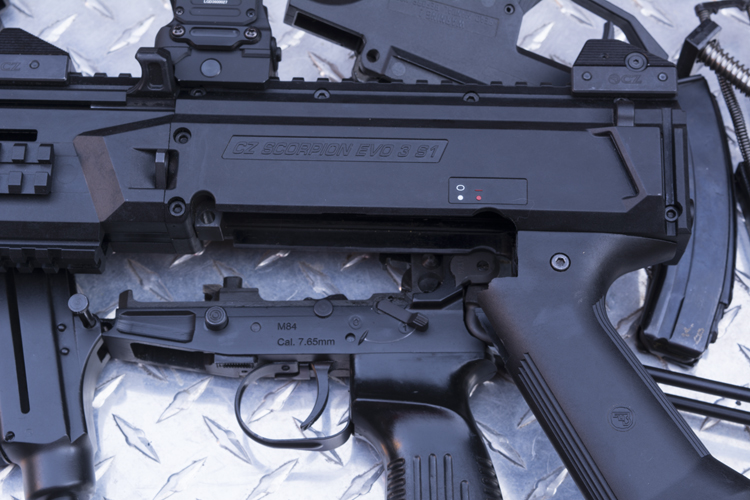
But let’s not forget some of the more important factors in the appeal of the Skorpion: the wire stock that folds overtop? So awesome. Although, unfortunately, sized for the kind of people who would fall to a .32. But this is the ultimate machine pistol and you don’t realize its value until you run it really fast. Then it’s actually scarily easy to crack off a mag into a big ragged hole, while going full cyclic. And wait…if you had standard, 20 round magazines, isn’t that the equivalent of shooting something twice with SSG buckshot out of a 12 gauge? Nobody’s arguing the effectiveness of that round, so we’re just going to absurdly declare that the Vz. 61 Skorpion makes sense, and if you argue we’ll put our fingers in our ears and shout things about the proletariat until you go away.
Well, the days of the Vz. 61 couldn’t last. It was too weird; Andreas Baader and Ulrike Meinhof hung themselves in their cells, the Israelis got Carlos the Jackal, and Jeff Cooper developed the 10mm Auto, destroying Communism forever. Perhaps as a result of their personal experience with totalitarian regimes, however, the citizens of former Soviet states adapted quickly to freedom and kept on designing firearms, often perfecting designs which were then made available to private citizens. Never again, comrades: excellent work.
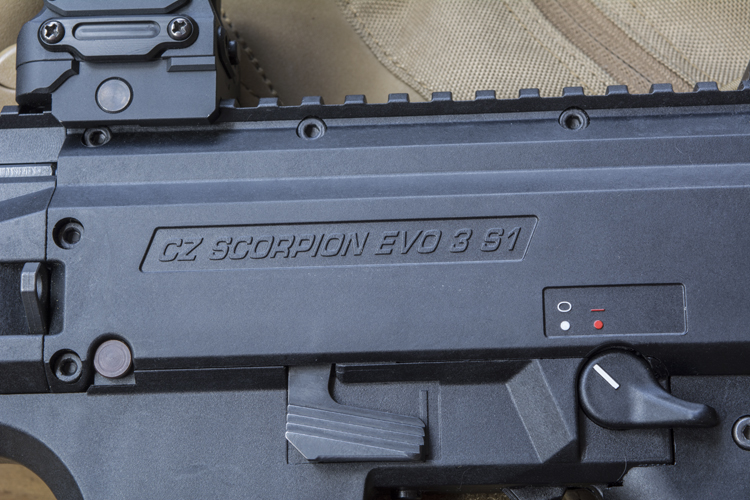
The Czechs in particular leapt ahead, recognizing the philosophical value of firearms as well as following through on a particular cultural inclination towards mechanical excellence. The CZ-75, already found in the hands of police and military organizations around the globe, developed from a blunt service pistol into a dominating force in international shooting competitions, and the Skorpion went from being a quirky footnote of stamped steel and brutal forgings to an oh-my-god-it’s-in-James-Bond-movies submachine gun.
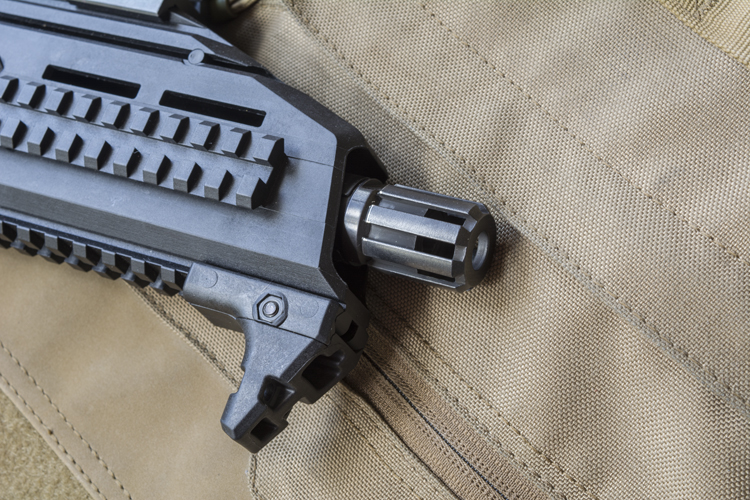
Handling the Evo 3 is interesting. It’s a radically different gun than the Skorpion. Far from its micro machine pistol beginnings, it’s now a briefcase-sized SWAT gun. In place of the original’s stamped steel safety that hooks into a grinder cut to hold it in position, there’s an ambidextrous polymer safety with multi-coloured position indicators. In place of the crude mag release (which, to be fair, does line up perfectly with the user’s thumb if the mag is grabbed with the left hand) there is now one of the best mag releases we’ve ever seen, activated by the trigger finger and located at the front of the trigger guard, which engages by pressing it forward and which positively launches empties out of the magwell. Where once were rough but effective irons, as long as your expectations weren’t too high, are now rail-mounted sights, in this case fore and aft of a DI Optical red dot. The stock still folds, but now it swings to the side, and the length of pull is adjustable on the fly. The charging handle is now really a handle, not just weird little nubs, and it’s non-reciprocating. The ejection port is in a normal location, tossing brass off to the right in a predictable manner, instead of off the ceiling and into the shooter’s head. About the only features that haven’t changed are the blowback operation (although the strange dampener is gone) and the location of the magazine well. Quite an update.
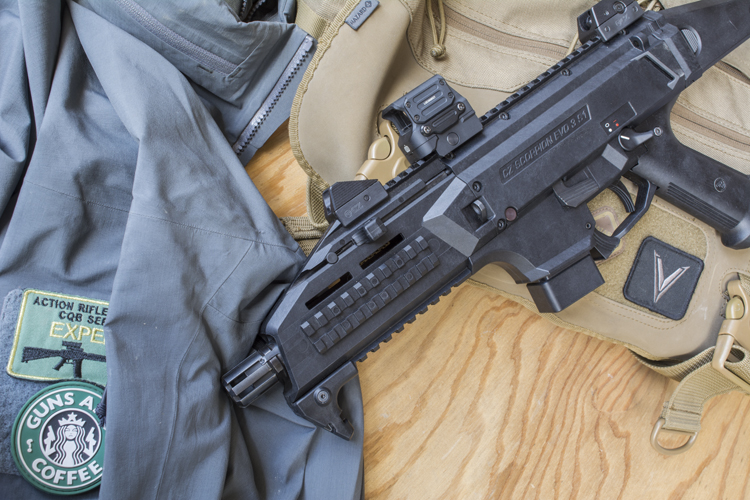
But, although it wasn’t apparent at first sight, there’s more 61-era heritage left in the Scorpion Evo 3 than meets the eye. The trigger group is functionally similar, just much more refined. On field stripping them together, similarities in the bolt carrier system jump out that are more fundamental than the differences. Sure, it’s now one big recoil spring instead of two little ones, and it’s been located entirely behind the barrel, but it’s just a scaled up version, designed to take advantage of modern machining methods. Evolution, indeed.
And the Evo 3 has a lot to recommend it. We love the fact that the magazines are now actually reliable, straight from the factory, without needing a microscope to evaluate the feed lips. The non-reciprocating charge handle that locks upwards like an MP5. The ability to use ammunition that can, with just one round, actually put down something larger than an underweight marmot. In short, in every way other than size, the Evo 3 can’t really be compared to the Vz. 61; it’s a functional, modern, submachine gun, of course spayed and/or neutered to comply with Canadian gun laws (we’re going with spayed because we’ve decided we want to think of both of these guns as female.)
But which one do we love in this Skorpion vs Scorpion contest after spending some quality time together?
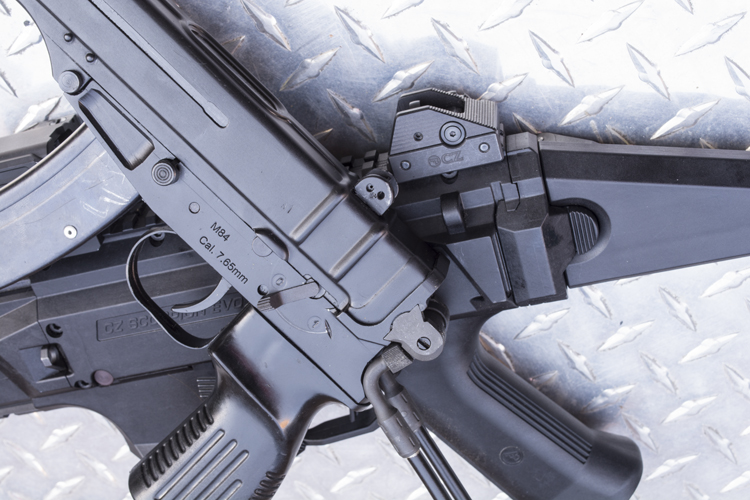
There’s just no other way to look at this: in every measurable way other than compactness, the CZ Scorpion Evo 3 is flat out superior to the original design. The recoil is definitely stouter, which is inherent in all blowback 9mm designs, but it’s markedly less than any rifle; even the heavy Brugger and Thomet APC 223 reviewed elsewhere in this issue has more recoil. The lightweight Scorpion is radically more maneuverable than any carbine, and the muzzle blast is far more tolerable than even a full-sized .223; cut an AR-15 down to a ten or twelve inch barrel and there is no comparison. An entry-sized AR will rattle out your fillings if used indoors or near range walls; the Scorpion, on the other hand, is pretty pleasant to use even in tight quarters. The Evo 3 makes a good deal of sense for a lot of practical applications, and it’s a really fun gun that will very easily put magazine after magazine in a six inch circle at 50 yards with no special effort. Shooting one with a red dot, like the DI Optical FC1 that this one came with, was just cheating.
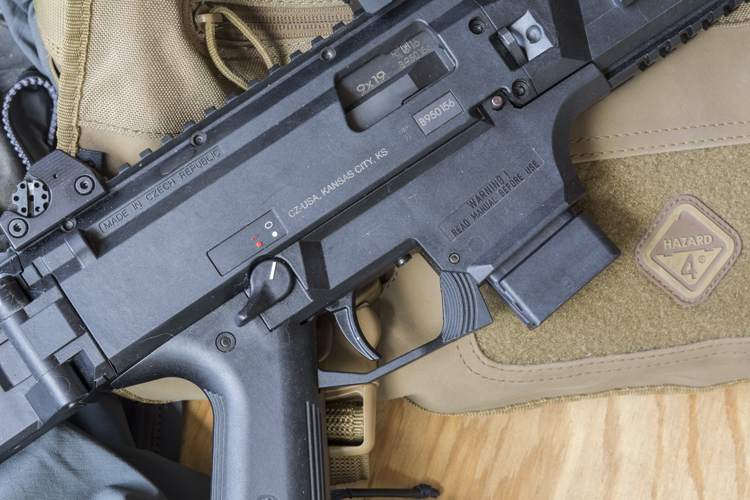
And the Vz. 61 Skorpion? Definitely not as practical. Definitely not as reliable. Definitely shoots a weird calibre and prefers round nose FMJ bullets over everything else and definitely has primitive sights that are way too close to your face. But man, it is just so hot. And people love it. We couldn’t take it out of the case without people asking about it, and everyone who shot it loved it, just because it’s so weird and fun. There’s no recoil, there’s no muzzle blast, and the faster you shoot it the better it seems to run. But there’s no denying that most of the appeal is nostalgia.
If we could only have one…it’s a tough call. If we needed to use it for work, it’d be the CZ Scorpion Evo 3, hands down. It’s a solid, dependable pistol calibre carbine. But for a toy? We just can’t turn down the original Skorpion.